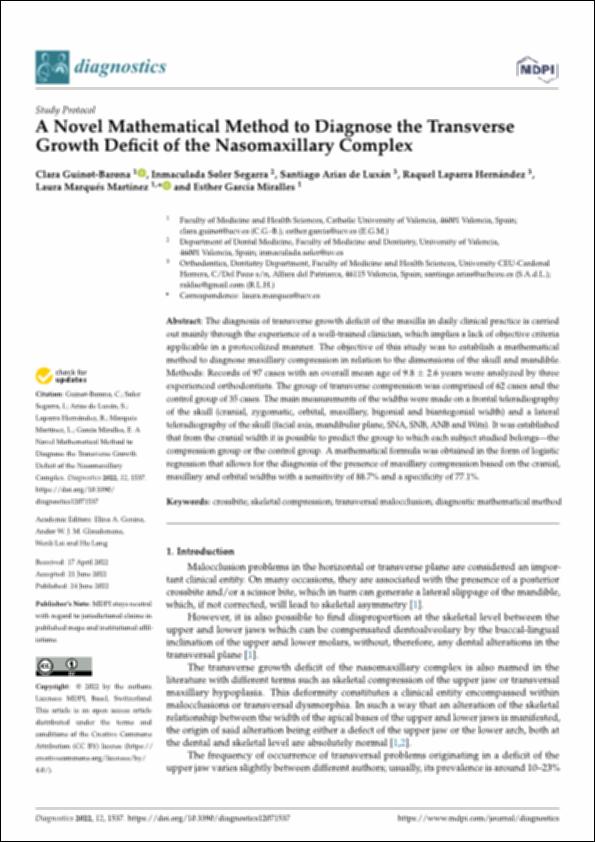Por favor, use este identificador para citar o enlazar este ítem:
http://hdl.handle.net/10637/14385A novel mathematical method to diagnose the transverse growth deficit of the nasomaxillary complex
| Título : | A novel mathematical method to diagnose the transverse growth deficit of the nasomaxillary complex |
| Autor : | Guinot Barona, Clara Soler Segarra, Inmaculada Arias de Luxán, Santiago Laparra Hernández, Raquel Marqués Martínez, Laura García Miralles, Esther |
| Materias: | Mordida (Odontología) - Diagnóstico - Modelos matemáticos.; Maloclusión - Diagnóstico - Modelos matemáticos.; Malocclusion - Diagnosis - Mathematical models.; Open bite - Diagnosis - Mathematical models. |
| Editorial : | MDPI |
| Citación : | Guinot-Barona, C., Soler Segarra, I., Arias de Luxán, S., Laparra Hernández, R., Marqués Martínez, L. & García Miralles, E. (2022). A novel mathematical method to diagnose the transverse growth deficit of the nasomaxillary complex. Diagnostics, vol. 12, i. 7 (24 jun.), art. 1537. DOI: https://doi.org/10.3390/diagnostics12071537 |
| Resumen : | The diagnosis of transverse growth deficit of the maxilla in daily clinical practice is carried out mainly through the experience of a well-trained clinician, which implies a lack of objective criteria applicable in a protocolized manner. The objective of this study was to establish a mathematical method to diagnose maxillary compression in relation to the dimensions of the skull and mandible. Methods: Records of 97 cases with an overall mean age of 9.8 2.6 years were analyzed by three experienced orthodontists. The group of transverse compression was comprised of 62 cases and the control group of 35 cases. Themainmeasurements of the widths weremade on a frontal teleradiography of the skull (cranial, zygomatic, orbital, maxillary, bigonial and biantegonial width) and a lateral teleradiography of the skull (facial axis,mandibular plane, SNA, SNB, ANB andWits). It was established that from the cranial width it is possible to predict the group to which each subject studied belongs—the compression group or the control group. A mathematical formula was obtained in the form of logistic regression that allows for the diagnosis of the presence of maxillary compression based on the cranial, maxillary and orbital widths with a sensitivity of 88.7% and a specificity of 77.1%. |
| Descripción : | Este artículo se encuentra disponible en la siguiente URL: https://www.mdpi.com/2075-4418/12/7/1537 Este artículo de investigación pertenece al número especial "Advances in Orthodontic Diagnosis and Treatment". |
| URI : | http://hdl.handle.net/10637/14385 |
| Derechos: | http://creativecommons.org/licenses/by/4.0/deed.es |
| ISSN : | 2075-4418 (Electrónico) |
| Idioma: | es |
| Fecha de publicación : | 24-jun-2022 |
| Centro : | Universidad Cardenal Herrera-CEU |
| Aparece en las colecciones: | Dpto. Odontología |
Los ítems de DSpace están protegidos por copyright, con todos los derechos reservados, a menos que se indique lo contrario.


